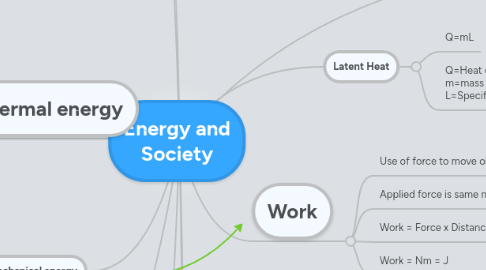
1. HEAT?
1.1. Heat is transferred until equilibrium is reached
1.2. Is the transfer of energy from a hot object to a colder object
1.3. 3 Methods - Radiation - Conduction - Convection
1.4. Q=mc x T
1.5. J/kg.C
1.6. Qlost=-Qgained
2. E associated with Motion
2.1. Electrical E
2.2. Thermal E
2.3. Radiant E
2.3.1. From the sun
2.4. Kinetic E
2.4.1. Energy in moving objects
2.4.2. Ek=1/2 x m x V^2
2.5. Sound E
3. Mechanical energy
3.1. Ability to do work
3.2. Total Energy = Et=Ek+Eg
3.3. (Initial)Ek+Eg=(Final)Ek+Eg
3.4. A 3.0 kg stone is thrown at 10 m/s [down] from a 15m high building. What is the velocity of the stone when it is 2.0 m above the ground?
3.5. Answer: (9.8)x15+ 0.5x10^2 = 9.8x2 + .5xv^2 = 19m/s (down)
4. % Efficiency
4.1. =(Eout / Ein) x100
5. Power
5.1. Rate at which a certain amount of work is done
5.2. Measured in Watts W, (J/t)
5.3. 1 HP = 750 Watts
6. Thermal energy
6.1. Is the total energy of all the molecules
6.2. Temperature: - measure of average kinetic energy of particles expressed in units or degrees
6.3. Absolute Zero: (-273.15 C) by William Thomson undergo: - superconductivity - superfluidity
7. Thermal Energy Methods
7.1. Conduction
7.1.1. Transfer of heat between substances that are in direct contact with each other. The better the conducter, the more rapidly heat will transfer
7.2. Convection
7.2.1. Up and down movement of gases and liquids caused by heat transfer
7.3. Radiation
7.3.1. Electromagnetic waves travelling through space
8. Potential Energy
8.1. Gravitational PE
8.1.1. Depends on height for E
8.1.2. Eg=m x g x h
8.2. Chemical PE
8.2.1. Stored in fuel, food, batteries, etc.
8.3. Elastic
8.3.1. Stored in stretched or squashed objects
8.4. Nuclear
8.4.1. E stored in nuclei
8.5. Magnetic
8.5.1. E in magnets and electromagnets
9. Work
9.1. Use of force to move object a certain distance
9.2. Applied force is same motion as displacement
9.3. Work = Force x Distance
9.4. Work = Nm = J
10. Latent Heat
10.1. Q=mL
10.2. Q=Heat change J m=mass Kg L=Specific latent heat J Kg-1
11. ENERGY RESOURCES
11.1. Raw material obtained from nature to be used for wok
11.2. Non Renewable
11.2.1. Uranium
11.2.1.1. U235 to fuel pelletes
11.2.1.2. Neutron is put close to the fuel and nuclear fission occurs
11.2.1.3. Uranium breaks apart and releases energy
11.2.1.4. the steam then turns turbines to make electricitiy
11.2.2. Althabasca Tar Sands
11.2.2.1. takes 50% of energy to mine tar below surface
11.2.2.2. Only 10% of Bitumen can be mined on surface
11.2.3. Fossil Fuels
11.2.3.1. composed of hydrocarbons
11.2.3.2. burnt to produce steam to spin turbines to create electricity
11.3. Renewable
11.3.1. Solar
11.3.1.1. Passive solar heating
11.3.1.1.1. designing building or structure to take advantage of the sun's energy at all times of the year
11.3.1.2. Active solar heating
11.3.1.2.1. Absorbs sun's energy and converts it to electricity
11.3.2. Wind
11.3.2.1. Kinetic energy from wind turns turbines to produce Electricity
11.3.3. Tidal
11.3.3.1. gravitational force of moon and sun
11.3.3.2. cause tidal waves that move turbines to produce electricity
11.3.3.3. affects ecosystem, doesnt produce electricity all the time
11.3.4. Biomass
11.3.4.1. Chemical Potential Energy stored in plans and animals
11.3.4.2. Burn trash to produce heat
11.3.4.3. fermentation to produce methane and ethane
11.3.5. Geothermal
11.3.5.1. Thermal energy taken from beneath earth's surface
11.3.6. Nuclear Fusion
11.3.6.1. Nuclei of atoms of light elements join together at extremely high temperature
11.3.7. Fuel Cell
11.3.7.1. Hydrogen combines with O2 with a catalyst creating electricity and water

